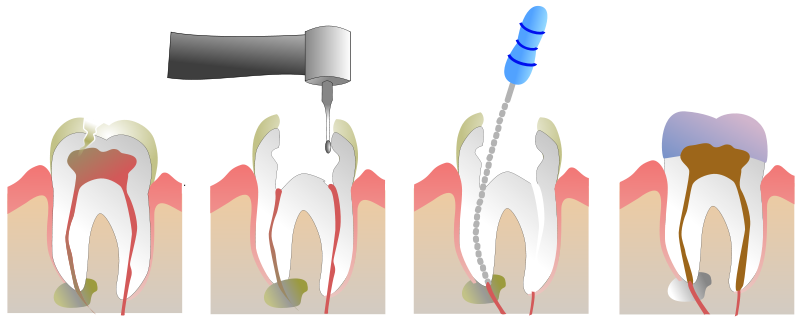Root Canal Therapy (Endodontics)
A root canal therapy is a treatment
used to repair and save a tooth that is badly decayed or becomes
infected. During a root canal procedure,the nerve and pulp
are removed and inside the tooth is cleaned and sealed.Without
treatment, the tissue surrounding the tooth will become infected
and abscesses may form.
"Root canal" is the term used to
describe the natural cavity within the center of the tooth.
The pulp is the soft tissue within the root canal. The tooth's
nerve lies within the root canal.
Why Does the Pulp Need to Be Removed?
When nerve tissue or pulp is damaged, it
breaks down and bacteria begin to multiply within the pulp
chamber. The bacteria and other decayed debris can cause an
infection or abscessed tooth. An abscess is a pus-filled pocket
that forms at the end of the roots of the tooth. An abscess
occurs when the infection spreads all the way past the ends
of the roots of the tooth. In addition to an abscess, an infection
in the root canal of a tooth can cause:
-> Swelling that may spread to other
areas of the face, neck, or head
-> Bone loss around the tip of the root
-> Drainage problems extending outward from the root. A
hole can occur through the side of the tooth with drainage
into the gums or through the cheek with drainage into the
skin.
What Damages a Tooth's Nerve and Pulp in the First Place?
Nerve and pulp can become irritated, inflamed
and infected due to deep decay, repeated dental procedures
on a tooth and/or large fillings, a crack or chip in the tooth,
or trauma to the tooth.
What Should One Expect After the
Root Canal?
For the first few days following the completion
of treatment, the tooth may feel sensitive due to natural
tissue inflammation, especially if there was pain or infection
before the procedure. This sensitivity or discomfort usually
can be controlled with over-the-counter pain medications such
as ibuprofen (Advil, Nurofen) or Panadol.
Until your root canal procedure is completely
finished – that is to say, the permanent filling is in place
and/or the crown, it's wise to minimize chewing on the tooth
under repair. This step will help avoid recontamination of
the interior of the tooth and also may prevent a fragile tooth
from breaking before the tooth can be fully restored.
How Successful Are Root Canals?
Root canal treatment is highly successful;
the procedure has more than a 90% success rate. Many teeth
fixed with a root canal can last a lifetime but complications
of the root canal system, existing infection, vertical root
fracture, deep caries ,periodontal diseases,marginal leackage
of the permanent fillings can lead to failiure of the treatment.
Complications of a Root Canal
Despite your dentist's best efforts to clean
and seal a tooth, new infections might emerge. Among the likely
reasons for this include:
-> More than the normally anticipated
number of root canals in a tooth (leaving one of them uncleaned)
-> An undetected crack in the root of a tooth
-> A defective or inadequate dental restoration that has
allowed bacteria to get past the restoration into the inner
aspects of the tooth and recontaminate the area
-> A breakdown of the inner sealing material over time,
allowing bacteria to recontaminate the inner aspects of the
tooth
Sometimes retreatment can be successful,
other times endodontic surgery must be tried in order to save
the tooth. The most common endodontic surgical procedure is
an apicoectomy or root-end resection. This procedure relieves
the inflammation or infection in the bony area around the
end of your tooth that continues after endodontic treatment.
In this procedure, the gum tissue is opened, the infected
tissue is removed, and sometimes the very end of the root
is removed. A small filling may be placed to seal the root
canal.
What Are the Signs that a Root Canal
Is Needed?
Sometimes no symptoms are present; however,
signs to look for include:
-> Severe toothache pain upon chewing
or application of pressure
-> Prolonged sensitivity/pain to heat or cold temperatures
(after the hot or cold has been removed)
-> Discoloration (a darkening) of the tooth
-> Swelling and tenderness in the nearby gums
-> A persistent or recurring pimple on the gums
What Happens During the Procedure?
A root canal requires one or more office
visits and can be performed by a dentist or endodontist. An
endodontist is a dentist who specializes in the causes, diagnosis,
prevention and treatment of diseases and injuries of the human
dental pulp or the nerve of the tooth. The choice of which
type of dentist to use depends to some degree on the difficulty
of the root canal procedure needed in your particular tooth
and the general dentist's comfort level in working on your
tooth. Your dentist will discuss who might be best suited
to perform the work in your particular case.

What Happens During the Procedure?
The first step in the procedure is to take
an X-ray to see the shape of the root canals and determine
if there are any signs of infection in a surrounding bone.
Your dentist or endodontist will then use local anesthesia
to numb the area near the tooth. Anesthesia may not be necessary,
since the nerve is dead, but most dentists still anesthetize
the area to make the patient more relaxed and at ease.
Next, to keep the area dry and free of saliva
during treatment, your dentist will place a rubber dam (a
sheet of rubber) around the tooth.
An access hole will then be drilled into
the tooth. The pulp along with bacteria, the decayed nerve
tissue and related debris is removed from the tooth. The cleaning
out process is accomplished using root canal files. A series
of these files of increasing diameter are each subsequently
placed into the access hole and worked down the full length
of the tooth to scrape and scrub the sides of the root canals.
Water or sodium hypochlorite is used periodically to flush
away the debris.
Once the tooth is thoroughly cleaned, it
is sealed. Some dentists like to wait a week before sealing
the tooth. For instance, if there is an infection, your dentist
may put a medication inside the tooth to clear it up. Others
may choose to seal the tooth the same day it is cleaned out.
If the root canal is not completed on the same day, a temporary
filling is placed in the exterior hole in the tooth to keep
contaminants out between appointments.
At the next appointment, to fill the interior
of the tooth, a sealer paste and a rubber compound called
gutta percha is placed into the tooth's root canal. To fill
the exterior access hole created at the beginning of treatment,
a filling is placed.
The final step may involve further restoration
of the tooth. Because a tooth that needs a root canal often
is one that has a large filling or extensive decay or other
weakness, a crown, crown and post or other restoration often
needs to be placed on the tooth to protect it, prevent it
from breaking and restore it to full function. Your dentist
will discuss the need for any additional dental work with
you.
back to top
|





